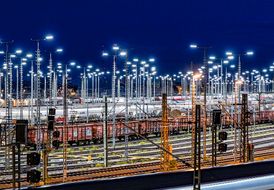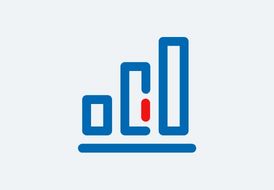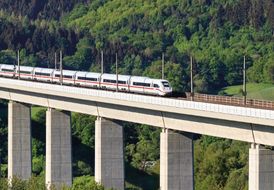Punctuality
Development in the year under review
PUNCTUALITY / % | 2021 | 2020 | 2019 | |
DB Group (rail) in Germany | 93.7 | 95.1 | 93.7 | |
DB rail passenger transport in Germany | 93.8 | 95.2 | 93.9 | |
DB Long-Distance | 75.2 | 81.8 | 75.9 | |
DB Regional | 94.3 | 95.6 | 94.3 | |
DB Cargo (Germany) | 69.8 | 77.6 | 73.8 | |
DB Arriva (rail: United Kingdom, Denmark, Sweden, | 93.5 | 92.3 | 87.6 | |
DB Regional (bus) | 83.9 | 83.4 | 81.6 | |
DB Cargo | 69.5 | 76.9 | 74.0 | |
To measure punctuality, we compare the target arrival time to the actual arrival time for every train/bus run. We summarize the arrival of trains/buses on schedule or up to a definedmaximum delay using a degree of punctuality.
1) Change in method in UK Trains line of business in 2021, previous years’ figures retroactively adjusted.
In 2021, punctuality in German rail transport was below the high level of the previous year. The main reason for this was the reduction in positive effects in terms of capacity, which therefore increased punctuality, due to the low volume produced in 2020 as a result of Covid-19.
- Positive effects resulted from a further reduction in primary disruptions thanks to improved system availability.
- Major structural and external challenges, in contrast, had a strong negative impact on punctuality. Structurally, strong traffic growth, primarily in existing bottlenecks (top connection hubs and lines), together with an expansion of construction volume in these areas, placed a significant strain on capacity. To counteract this development, measures have been adopted to contribute to an increase in quality in the coming years.
- A large number of external special events also led to temporary slumps in punctuality during the course of the year: the severe cold spell in February 2021, high temperatures in June 2021, the severe floods in July 2021 and storms in October 2021.
- The GDL strikes also had a negative effect.
Significant measures for improvement
In 2021, DB Group again implemented a large number of measures to reduce the level of disruptions in vehicles and network systems, which have a direct impact on punctuality.This reduced the number of primary disruptions. The impact of a primary disruption depends heavily on network utilization. The greater the utilization of a particular network section, the higher the probability that several trains will be affected by a disruption. Due to the increase in train-path demand and the extensive construction activities in infrastructure, the capacity utilization of the network has increased so sharply that, despite a lower level of disruption, the effects of traffic jams have increased sharply. As a result, punctuality targets were missed. Owing to this development, in addition to continued improvement of disruption levels, measures focusing on better capacity management are also being developed and implemented.
Significant growth in rail freight transport is indispensable for the success of Germany’s transition to more sustainable mobility and transport. In 2021, measures were developed designed to have short-term and medium-term effects on quality and punctuality in rail freight transport. For example, it was decided to pilot an additional plan corridor with control elements to increase punctuality on the important Rail Freight Corridor (RFC) 1 between Rotterdam and Genoa. In addition, since the second half of 2021, there has been intensified international coordination of construction measures in order to reduce negative effects on rail freight transport. The implementation of the measures was started and has already been partially completed. The implementation and effectiveness of the measures are reviewed regularly, and countermeasures and further developments are formulated if necessary. Additional priorities for rail freight transport, both reactively (disruptions) and preventatively (impending risks), were examines (such as cross-border freight transport, train preparation in shunting yards and schedules for freight transport in construction projects), and recommendations for action were created.
We are expanding our expertise in the area of forecasting quality indicators with the aim of detecting punctuality-related developments at an early stage and taking measures. The focus is on the medium-term planning horizon. This will show to what extent the planned quality measures are sufficient to achieve our punctuality targets. The models for the punctuality forecast during the business year were continuously expanded in 2021, so that they better take into account key drivers such as weather developments, the availability of vehicles, infrastructure issues and the utilization of our products.
The S-Bahn (metro) systems in major cities play a key role in Germany’s transition to more sustainable mobility. They will have to cope with significant growth over the next few years while also increasing the quality of service. In particular, punctuality must increase significantly over the next five years, and train cancellations must be reduced. For this purpose, the Strong S-Bahn (metro) program was launched with the aim of developing and implementing the requirements for high-performance S-Bahn (metro) systems. As part of this program, locally tested approaches, such as the prevention of track crossings on the Munich S-Bahn (metro), are being implemented as standards for the major cities. The focus of the Strong S-Bahn (metro) program is on the core resources of S-Bahn (metro) systems, in particular track infrastructure, platforms, vehicles, system technologies and, not least, our personnel. In order to improve operational quality, the core processes of rail production are to be strengthened, primarily planning and control, operating and maintenance. The experience we gained in 2020, and which contributed to an increase in punctuality, is also being incorporated into this. For example, findings from the reduced number of passengers are being used to create measures for the period following the Covid-19 pandemic, such as adjusting platform design, timetable adjustments and infrastructure improvements. These activities will help to achieve the S-Bahn (metro) punctuality targets.
- Construction management center: In 2021, cascading performance dialogs were introduced, which facilitate continuous control of issues such as construction-related restrictions on infrastructure, and also enable cross-divisional and cross-level control. The increased volume of traffic in connection with impending supply and schedule bottlenecks, as well as extreme weather events, placed high demands on construction implementation in 2021. The management center for construction and construction operations technology now intervenes earlier in the overall optimization of construction activities, for example through predictive optimization of required track closures or early identification of critical constellations by analyzing track-kilometer downtime. Joint regional and central efforts have contributed to achieving the annual objectives for construction-related restrictions in scheduled long-distance rail passenger transport, despite additional infrastructure measures.
- Punctuality management center: Its core tasks include the analysis of punctuality discrepancies during the year, the identification and management of measures and monitoring the implementation of measures. The punctuality management center relies on an established early-warning system for punctuality-related (construction) planning and (construction) operating processes: PlanRadar and the construction risk radar. In 2021, the early-warning system was expanded to include rail freight transport. Concrete measures for a sustainable improvement in punctuality were derived and initiated. This includes the development of a four-month construction preview for the Rail Freight Corridor 1 between Rotterdam and Genoa.
Um die Verkehrswende erfolgreich umzusetzen, ist ein signifikantes Wachstum im Schienengüterverkehr unerlässlich. 2021 wurden Maßnahmen mit kurz- und mittelfristiger Wirkung auf die Qualität und Pünktlichkeit im Schienengüterverkehr erarbeitet. So wurde bspw. entschieden, einen zusätzlichen Plankorridor mit seinen Steuerungselementen zur Steigerung der Pünktlichkeit auf dem für den Schienengüterverkehr wichtigen Rail Freight Corridor (RFC) 1 zwischen Rotterdam und Genua zu pilotieren. Darüber hinaus erfolgt seit dem zweiten Halbjahr 2021 eine intensivierte internationale Abstimmung von Baumaßnahmen, um die negativen Einflüsse auf den Schienengüterverkehr zu reduzieren. Die Umsetzung der Maßnahmen wurde begonnen und teilweise bereits abgeschlossen. Umsetzung und Wirksamkeit der Maßnahmen werden regelmäßig überprüft und erforderlichenfalls Gegensteuerungsmaßnahmen und Weiterentwicklungen abgeleitet. Zudem wurden zusätzliche Schwerpunkte des Schienengüterverkehrs sowohl reaktiv (Störfälle) als auch präventiv (drohende Risiken) geprüft (z.B. grenzüberschreitende Güterverkehre, Zugvorbereitung in Rangierbahnhöfen und Fahrplanungen Güterverkehr in Baumaßnahmen) und Handlungsempfehlungen abgeleitet.
Wir bauen unsere Kompetenz im Bereich der Prognose von Qualitätskennzahlen aus, mit dem Ziel, pünktlichkeitsrelevante Entwicklungen frühzeitig zu erkennen und Maßnahmen zu ergreifen. Im Fokus steht dabei der mittelfristige Planungshorizont. Es wird aufgezeigt, inwiefern die geplanten Qualitätsmaßnahmen ausreichen, um unsere Pünktlichkeitsziele zu erreichen. Die Modelle für die unterjährige Pünktlichkeitsprognose wurden 2021 kontinuierlich erweitert, sodass sie maßgebliche Treiber wie Wetterentwicklungen, die Verfügbarkeit von Fahrzeugen, Infrastrukturthemen und die Auslastung unserer Produkte besser berücksichtigen.
Auf die S-Bahnen der großen Metropolen kommt eine Schlüsselrolle in Deutschlands Verkehrswende zu. Sie werden in den nächsten Jahren ein signifikantes Wachstum zu meistern haben – bei gleichzeitiger Qualitätssteigerung. Insbesondere soll die Pünktlichkeit in den nächsten fünf Jahren deutlich gesteigert und zugleich sollen Zugausfälle verringert werden. Hierfür wurde das Programm Starke S-Bahn gestartet, mit dem Ziel, die Voraussetzungen für hochperformante S-Bahn-Systeme zu entwickeln und umzusetzen. Dabei werden lokal erprobte Ansätze, wie z.B. die Verhinderung von Gleisübertritten bei der S-Bahn München, als Standards für die Metropolen umgesetzt.
Im Fokus des Programms Starke S-Bahn stehen die Kernressourcen der S-Bahn-Systeme, insbesondere die Fahrwege, die Bahnsteige, die Fahrzeuge, die Systemtechnologien und nicht zuletzt unser Personal. Damit die Betriebsqualität verbessert werden kann, sollen die Kernprozesse der Bahnproduktion, v.a. die Planung und Steuerung, die Durchführung und die Instandhaltung, gestärkt werden. Hier fließen auch die Erfahrungen, die 2020 gesammelt wurden und zu einer Steigerung der Pünktlichkeit beigetragen haben, mit ein. So werden z.B. Erkenntnisse aus der reduzierten Reisendenzahl genutzt, um Maßnahmen für die Zeit nach der Corona-Pandemie abzuleiten, wie z.B. die Anpassung der Bahnsteiggestaltung, Fahrplananpassungen und Infrastrukturverbesserungen. Diese Aktivitäten unterstützen dabei, dass die Pünktlichkeitsziele für die S-Bahnen erreicht werden.
- Lagezentrum Bau: 2021 wurden kaskadierende Performance-Dialoge eingeführt, die eine durchgängige Steuerung u.a. der baubetrieblichen Einschränkungen der Infrastruktur monitoren und hierüber eine bereichs- und ebenenübergreifende Steuerung ermöglichen. Das wieder gestiegene Verkehrsaufkommen in Verbindung mit drohenden Versorgungs- und fahrplanerischen Engpässen sowie Extremwetterereignisse stellten hohe Anforderungen an die Baudurchführung in 2021 dar. Über vorausschauende Optimierung etwa der erforderlichen Sperrzeitstunden oder frühzeitiger Identifikation kritischer Konstellationen mittels Analyse der Gleiskilometersperrstunden greift das Lagezentrum Bau und Baubetriebstechnologie nunmehr frühzeitiger in eine gesamthafte Optimierung des Baugeschehens ein. Gemeinsame regionale und zentrale Anstrengungen haben dazu beigetragen, dass die Jahresziele der baubetrieblichen Einschränkungen im vertakteten Schienenpersonenfernverkehr trotz zusätzlicher Infrastrukturmaßnahmen eingehalten werden konnte.
- Lagezentrum Pünktlichkeit: Zu den Kernaufgaben gehören die Analyse unterjähriger Pünktlichkeitszielabweichungen, die Maßnahmenidentifizierung und -steuerung sowie das Monitoring der Maßnahmenumsetzung. Das Lagezentrum greift dabei auf ein etabliertes Frühwarnsystem für pünktlichkeitsrelevante (Bau-)Planungen und (Bau-)Betriebsabläufe zurück: PlanRadar und Risiko Radar Bau. Das Frühwarnsystem wurde 2021 um den Schienengüterverkehr erweitert. Konkrete Maßnahmen für eine nachhaltige Verbesserung der Pünktlichkeit wurden abgeleitet und initiiert. Dazu gehört u.a. die Entwicklung einer Vier-Monats-Bauvorschau für den Rail Freight Corridor 1 zwischen Rotterdam und Genua.



